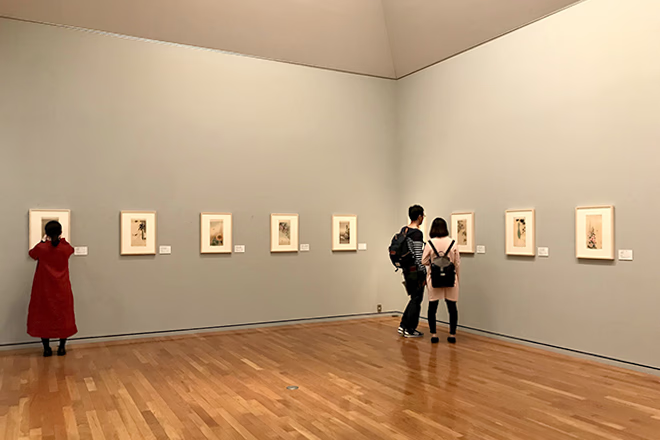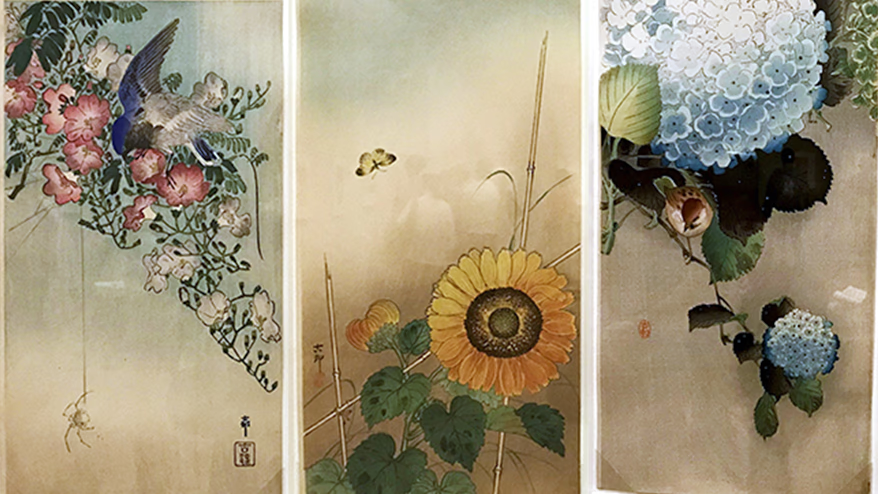私が日本画家の小原古邨(おはらこそん)を知ったのは茅ヶ崎市美術館公式のTwitter投稿から。
「踊る狐」と題された絵のなかで、蓮の葉っぱをかぶったきつねが両手をあげておどけた様子で踊っていた。ふわふわした毛並み、柔らかそうな肉球…。細部まで細かく丁寧に描かれた絵にひとめで心を奪われた。
きっとこの絵を描いた人は、生き物の瞳に映る小さな光、枯葉が落ちる様子まで、丁寧に命を宿すように描き込む人だと思った。
自宅から茅ヶ崎まで2時間ほどで行ける距離だとわかるとすぐ、週末に※茅ヶ崎市美術館に出かけることを決めていた。
※茅ヶ崎市美術館 開館20周年記念-版の美Ⅱ-原安三郎コレクション 小原古邨展ー花と鳥のエデンー
小原古邨(本名=小原又雄)は1877年金沢市生まれ。花鳥画を得意とする日本画家・鈴木華邨に師事。明治末期には版元・大黒屋から花鳥画を刊行し、海外への輸出を念頭に置いた版下絵の制作で高い人気を得る。昭和期には渡邊版画店から祥邨の名で、また酒井好古堂と川口商会の合版では豊邨の制作を続けた。
海外で評価されながら、国内ではあまり知られてこなかった小原の作品。本展では、摺および保存状態が優れた原コレクションから、古邨作品230点を世界初公開。祥邨、豊邨の作品も参考出品するほか、同コレクションの歌川広重や歌川国芳などの貴重な花鳥画10点も展示する。
引用:美術手帳
電車に乗って茅ヶ崎まで。
品川を通り過ぎると、高層ビルが姿を消して行く。
多摩川に差し掛かる頃には、車窓から見える景色が都会の景色から緑の多い郊外の景色へと変わっていく。実家へ帰省する際、新幹線の車窓から山が見え始めた頃から肩の力が抜けていくのと同じ感覚がした。
茅ヶ崎駅から10分ほど歩くと茅ヶ崎美術館に到着。高砂緑地と隣接しており、日本庭園を抜けた先に美術館が現れる。そこだけゆっくり時間が流れるように感じた。
日曜美術館で取り上げられ、入場制限がかかる日もあると聞いていたが、ゆっくり家を出たせいで到着したのが15時頃。列もなくすんなりと入場できた。

春から冬まで、季節を巡るように展示された作品たち。
春は梅の枝に止まる鶯、夏は向日葵に紋黄蝶、秋はたわわに実る柿に目白、冬はしんしんと降り積もる雪に鷺。
驚くのはその細やかさ。絵の情景が浮かび、描かれた生き物が目の前で動き出しそう。古邨の目で同じ景色を見ているような気分になる。
春は温かくも時折ひやっとした風が流れ、夏は蒸すように暑く、秋は果実が熟れた甘い空気が流れ、秋空は空高く、冬はしんしんと冷える。一枚の絵から、その場の空気までも感じ取れる。

帰り際、ご婦人に「月がきれいですよ。十五夜ですね。」と声をかけられる。
「どこから来られたんですか?」と聞くと、
「私は鎌倉から。午前中にバタバタ家事を終わらせて来たの。たまにはこういう時間も必要ね。本当にきてよかったわ」と。
私も深く頷いた。
ここまで来たなら海に寄って帰ろうと思い、茅ヶ崎サザンビーチへ足を向ける。
湘南の海と聞くと騒がしい印象を持っていたが、とても静かできれいな海だった。
日中よく晴れたため夕日がとてもきれいで、沈む夕日を眺めながらこんなことを思い出した。
上京して4ヶ月ほど経った頃、調子が悪くて会社を休み、夕方町医者に行った帰り道。
ビル街の隙間から燃えるような夕日が見えた。
徒歩で通勤していたので、その頃毎日歩いて通っていた道だが、初めて見る景色に見えた。
その道を通るのは、すっかり太陽が出て明るくなった午前中から、太陽がどっぷり沈んで真っ暗になる時間帯。
夕日なんていつぶりに見ただろう。
そもそも「夕日を見る」ということを忘れていた。
夕日がきれいだとか、空がきれいだとか、田舎に住んでいた頃は些細なことをよく感じ取っていたように思う。
都会で暮らし、仕事や遊びに忙しく、夕焼けの時間には建物のなかでパソコンを眺めていて、風景に心奪われるということもなければ、深く息をすることも忘れてしまっていた。
思えば、最近は自分の感情を持て余す日々が続いていた。
素敵な絵と静かな海を見て、久しぶりに深呼吸した気分で家路についた。

来年2019年2月から、渋谷の太田記念美術館で「小原古邨展」が開催されます。
小原古邨の小さな世界をぜひ一度ご覧になられてはいかがでしょうか。
http://www.ukiyoe-ota-muse.jp/exhibition/ohara-koson

